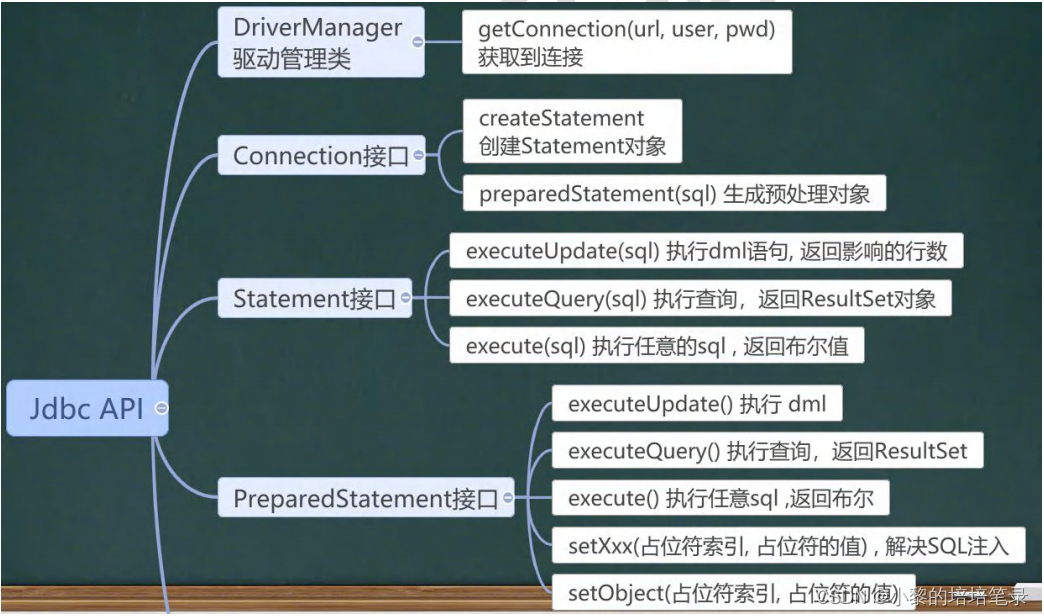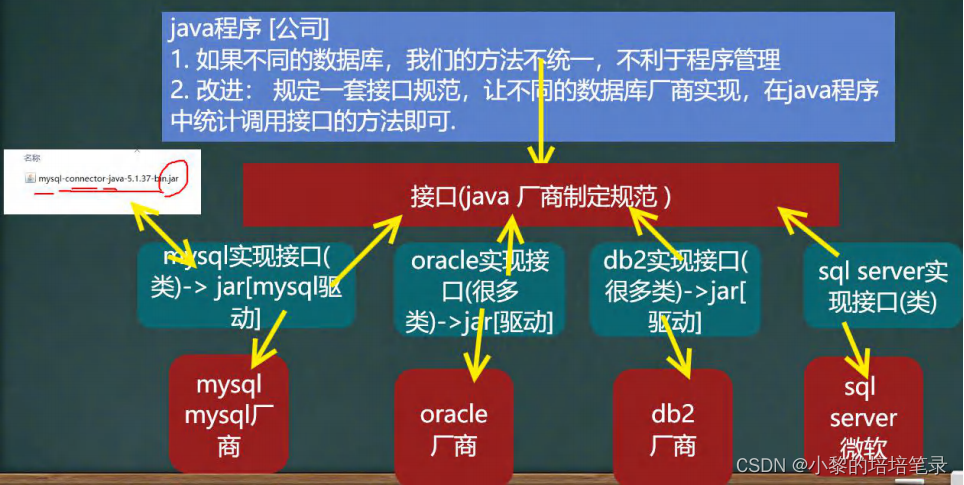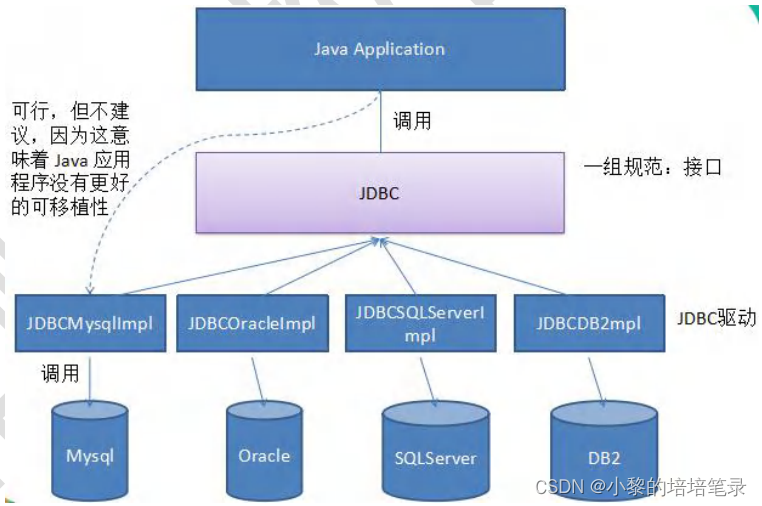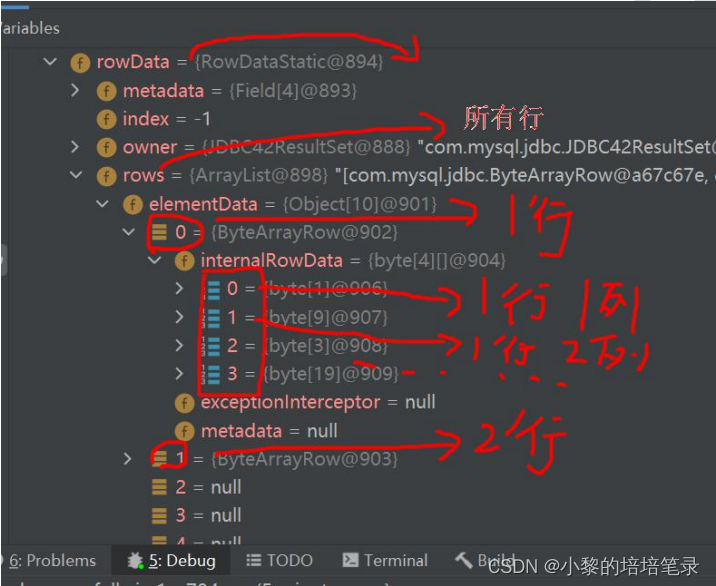目录
一、JDBC
1、基本介绍
? 概述
????????JDBC为访问不同的数据库提供了统一的接口,为使用者屏蔽了细节问题。Java程序员使用JDBC, 可以连接任何提供了JDBC驱动程序的数据库系统,从而完成对数据库的各种操作。
? 原理示意图
? JDBC的好处
????????JDBC是Java提供一套用于数据库操作的接口API, Java程序员只需要面向这套接口编程即可。不同的数据库厂商,需要针对这套接口,提供不同实现。
? API
????????JDBC API是一系列的接口, 它统一和规范了应用程序与数据库的连接、执行SQL 语句,井到得到返回结果等各类操作,相关类和接口在 java.sql与javax.sq包中。
2、JDBC 快速入门
? 编写步骤
- 注册驱动-加载Driver类
- 获取连接-得到Connection
- 执行增删改查-发送SQL给mysql执行
- 释放资源-关闭相关连接
? 第一个程序
public class Jdbc01 { public static void main(String[] args) throws SQLException { //前置工作: 在项目下创建一个文件夹比如 libs // 将 mysql.jar 拷贝到该目录下,点击 add to project ..加入到项目中 //1. 注册驱动 Driver driver = new Driver(); //创建 driver 对象 //2. 得到连接 //(1) jdbc:mysql:// 规定好表示协议,通过 jdbc 的方式连接 mysql //(2) localhost 主机,可以是 ip 地址 //(3) 3306 表示 mysql 监听的端口 //(4) hsp_db02 连接到 mysql dbms 的哪个数据库 //(5) mysql 的连接本质就是前面学过的 socket 连接 String url = "jdbc:mysql://localhost:3306/hsp_db02"; //将 用户名和密码放入到 Properties 对象 Properties properties = new Properties(); //说明 user 和 password 是规定好,后面的值根据实际情况写 properties.setProperty("user", "root");// 用户 properties.setProperty("password", "123"); //密码 Connection connect = driver.connect(url, properties); //3. 执行 sql String sql = "update actor set name='周星驰' where id = 1"; //statement 用于执行静态 SQL 语句并返回其生成的结果的对象 Statement statement = connect.createStatement(); int rows = statement.executeUpdate(sql); // 如果是 dml 语句,返回的就是影响行数 System.out.println(rows > 0 ? "成功" : "失败"); //4. 关闭连接资源 statement.close(); connect.close(); }3、获取数据库的五种方式
? 第一种方式
public void connect01() throws SQLException { Driver driver = new Driver(); //创建 driver 对象 String url = "jdbc:mysql://localhost:3306/hsp_db02"; //将 用户名和密码放入到 Properties 对象 Properties properties = new Properties(); //说明 user 和 password 是规定好,后面的值根据实际情况写 properties.setProperty("user", "root");// 用户 properties.setProperty("password", "123"); //密码 Connection connect = driver.connect(url, properties); System.out.println(connect); }? 第二种方式
public void connect02() throws Exception { //使用反射加载 Driver 类 , 动态加载,更加的灵活,减少依赖性 Class<?> aClass = Class.forName("com.mysql.jdbc.Driver"); Driver driver = (Driver)aClass.newInstance(); String url = "jdbc:mysql://localhost:3306/hsp_db02"; //将 用户名和密码放入到 Properties 对象 Properties properties = new Properties(); //说明 user 和 password 是规定好,后面的值根据实际情况写 properties.setProperty("user", "root");// 用户 properties.setProperty("password", "123"); //密码 Connection connect = driver.connect(url, properties); System.out.println("方式 2=" + connect); }??第三种方式
public void connect03() throws Exception { //使用反射加载 Driver Class<?> aClass = Class.forName("com.mysql.jdbc.Driver"); Driver driver = (Driver) aClass.newInstance(); //创建 url 和 user 和 password String url = "jdbc:mysql://localhost:3306/hsp_db02"; String user = "root"; String password = "123"; DriverManager.registerDriver(driver);//注册 Driver 驱动 Connection connection = DriverManager.getConnection(url, user, password); System.out.println("第三种方式=" + connection); }? 第四种方式
public void connect04() throws Exception { //使用反射加载了 Driver 类 //在加载 Driver 类时,完成注册 /* 源码: 1. 静态代码块,在类加载时,会执行一次. 2. DriverManager.registerDriver(new Driver()); 3. 因此注册 driver 的工作已经完成 static { try { DriverManager.registerDriver(new Driver()); } catch (SQLException var1) { throw new RuntimeException("Can't register driver!"); } } */ Class.forName("com.mysql.jdbc.Driver"); //创建 url 和 user 和 password String url = "jdbc:mysql://localhost:3306/hsp_db02"; String user = "root"; String password = "123"; Connection connection = DriverManager.getConnection(url, user, password); System.out.println("第 4 种方式~ " + connection); }? 第五种方式
?//使用配置文件,连接数据库更灵活 Connection connection = DriverManager.getConnection("jdbc:mysql://localhost:3306/testdb" "root""root"); //字符串各个值,比如端口,数据库,用户名,密码为了方便, //我们可以将信息写入到·properties 文件中,方便操作 //配置文件 jdbc.properties user=root password=root url-jdbc:mysgt://localhost:3306/girls driver=com.mysqljdbc.Driverpublic void connect05() throws Exception { //通过 Properties 对象获取配置文件的信息 Properties properties = new Properties(); properties.load(new FileInputStream("src\\mysql.properties")); //获取相关的值 String user = properties.getProperty("user"); String password = properties.getProperty("password"); String driver = properties.getProperty("driver"); String url = properties.getProperty("url"); Class.forName(driver);//建议写上 Connection connection = DriverManager.getConnection(url, user, password); System.out.println("方式 5 " + connection); }? 注意
? ? ? ? 1、mysqL驱动5.1.6可以无需CLass. forName("com.mysql.jdbc.Driver");
? ? ? ? 2、从jdk1.5以后使用了jdbc4,不再需要显示调用class.forName()注册驱动而是自动调用驱动jar包下META-INFservices java .sql.Driver文本中的类名称去注册。
? ? ? ? 3、建议还是写上CLass. forName("com.mysqljdbc.Driver'"),更加明确。
二、API?
1、ResultSet
? 基本介绍
? ? ? ? 1、表示数据库结果集的数据表, 通常通过执行查询数据库的语句生成。
? ? ? ? 2、ResultSet对象保持一个光标指向其当前的数据行。 最初,光标位于第一行之前。
? ? ? ? 3、next方法将光标移动到下一行,并且由于在ResultSet对象中没有更多行时返回false 因此可以在while循环中使用循环来遍历结果集。
? 应用实例
? 代码实例
public class ResultSet_ { public static void main(String[] args) throws Exception { //通过 Properties 对象获取配置文件的信息 Properties properties = new Properties(); properties.load(new FileInputStream("src\\mysql.properties")); //获取相关的值 String user = properties.getProperty("user"); String password = properties.getProperty("password"); String driver = properties.getProperty("driver"); String url = properties.getProperty("url"); //1. 注册驱动 Class.forName(driver);//建议写上 //2. 得到连接 Connection connection = DriverManager.getConnection(url, user, password); //3. 得到 Statement Statement statement = connection.createStatement(); //4. 组织 SqL String sql = "select id, name , sex, borndate from actor"; //执行给定的 SQL 语句,该语句返回单个 ResultSet 对象 ResultSet resultSet = statement.executeQuery(sql); //5. 使用 while 取出数据 while (resultSet.next()) { // 让光标向后移动,如果没有更多行,则返回 false int id = resultSet.getInt(1); //获取该行的第 1 列 //int id1 = resultSet.getInt("id"); 通过列名来获取值, 推荐 String name = resultSet.getString(2);//获取该行的第 2 列 String sex = resultSet.getString(3); Date date = resultSet.getDate(4); System.out.println(id + "\t" + name + "\t" + sex + "\t" + date); } //6. 关闭连接 resultSet.close(); statement.close(); connection.close(); }2、Statement
? 基本介绍
- Statement对象 用于执行静态SQL语句并返回其生成的结果的对象
- 在连接建立后,需要对数据库进行访问,执行命名或是SQL语句 可以通过:①Statement [存在SQL注入];②PreparedStatement [预处理];③CallableStatement [存储过程]
- Statement对象执行SQL语句,存在SQL注入风险
- SQL 注入是利用某些系统没有对用户输入的数据进行充分的检查, 而在用户输入数据中注入非法的SQL 语句段或命令,恶意攻击数据库。
- 要防范SQL 注入,只要用PreparedStatement(从Statement扩展而来)取代Statement 就可以了。
? sql 注入-- 创建一张表 管理员表 CREATE TABLE admin ( NAME VARCHAR(32) NOT NULL UNIQUE, pwd VARCHAR(32) NOT NULL DEFAULT '') CHARACTER SET utf8; -- 添加数据 INSERT INTO admin VALUES('tom', '123'); -- 查找某个管理是否存在 SELECT * FROM admin WHERE NAME = 'tom' AND pwd = '123' -- SQL -- 输入用户名 为 1' or -- 输入万能密码 为 or '1'= '1 SELECT * FROM admin WHERE NAME = '1' OR' AND pwd = 'OR '1'= '1' SELECT * FROM admin3、PreparedStatement
? 基本介绍
- PreparedStatement 执行的SQL 语句中的参数用问号(?)来表示,调用PreparedStatement 对象的 setXxx()?方法来设置这些参数 .setXxx()方法有两个参数,第一个参数是要设置的SQL语句中的参数的索引(从1开始),第二个是设置的SQL语句中的参数的值。
- 调用 executeQuery(): 返回 ResultSet 对象
- 调用 executeUpdate(): 执行更新,包括增、删、修改
? 预处理的好处
- 不再使用 +(加号) 拼接sq|语句,减少语法错误
- 有效的解决了sql注入问题!
- 大大减少了编译次数,效率较高
?public class PreparedStatement_ { public static void main(String[] args) throws Exception { Scanner scanner = new Scanner(System.in); //让用户输入管理员名和密码 System.out.print("请输入管理员的名字: "); //next(): 当接收到 空格或者 '就是表示结束,如果希望看到 SQL 注入,这里需要用 nextLine String admin_name = scanner.nextLine(); System.out.print("请输入管理员的密码: "); String admin_pwd = scanner.nextLine(); //通过 Properties 对象获取配置文件的信息 Properties properties = new Properties(); properties.load(new FileInputStream("src\\mysql.properties")); //获取相关的值 String user = properties.getProperty("user"); String password = properties.getProperty("password"); String driver = properties.getProperty("driver"); String url = properties.getProperty("url"); //1. 注册驱动 Class.forName(driver);//建议写上 //2. 得到连接 Connection connection = DriverManager.getConnection(url, user, password); //3. 得到 PreparedStatement //组织 SqL , Sql 语句的 ? 就相当于占位符 String sql = "select name , pwd from admin where name =? and pwd = ?"; //preparedStatement 对象实现了 PreparedStatement 接口的实现类的对象 PreparedStatement preparedStatement = connection.prepareStatement(sql); //给 ? 赋值 preparedStatement.setString(1, admin_name); preparedStatement.setString(2, admin_pwd); //4. 执行 select 语句使用 executeQuery //如果执行的是 dml(update, insert ,delete) executeUpdate() //这里执行 executeQuery ,不要在写 sql ResultSet resultSet = preparedStatement.executeQuery(sql); if (resultSet.next()) { //如果查询到一条记录,则说明该管理存在 System.out.println("恭喜, 登录成功"); } else { System.out.println("对不起,登录失败"); } //关闭连接 resultSet.close(); preparedStatement.close(); connection.close(); } }4、JDBC API小结

??
三、封装 JDBCUtils?
? 说明
?????????在jdbc操作中,获取连接和释放资源是经常使用到可以将其封装JDBC连接的工具类JDBCUtils
完成JDBCUtils
? 完成 mysql 的连接和关闭资源
public class JDBCUtils { //定义相关的属性(4 个), 因为只需要一份,因此,我们做出 static private static String user; //用户名 private static String password; //密码 private static String url; //url private static String driver; //驱动名 //在 static 代码块去初始化 static { try { Properties properties = new Properties(); properties.load(new FileInputStream("src\\mysql.properties")); //读取相关的属性值 user = properties.getProperty("user"); password = properties.getProperty("password"); url = properties.getProperty("url"); driver = properties.getProperty("driver"); } catch (IOException e) { //在实际开发中,我们可以这样处理 //1. 将编译异常转成 运行异常 //2. 调用者,可以选择捕获该异常,也可以选择默认处理该异常,比较方便. throw new RuntimeException(e); } }??连接数据库, 返回 Connection
public static Connection getConnection() { try { return DriverManager.getConnection(url, user, password); } catch (SQLException e) { //1. 将编译异常转成 运行异常 //2. 调用者,可以选择捕获该异常,也可以选择默认处理该异常,比较方便. throw new RuntimeException(e); } }??关闭相关资源
/* 1. ResultSet 结果集 2. Statement 或者 PreparedStatement 3. Connection 4. 如果需要关闭资源,就传入对象,否则传入 null */ public static void close(ResultSet set, Statement statement, Connection connection) { //判断是否为 null try { if (set != null) { set.close(); } if (statement != null) { statement.close(); } if (connection != null) { connection.close(); } } catch (SQLException e) { //将编译异常转成运行异常抛出 throw new RuntimeException(e); } }? 使用工具类完成select
public void testSelect() { //1. 得到连接 Connection connection = null; //2. 组织一个 sql String sql = "select * from actor where id = ?"; PreparedStatement preparedStatement = null; ResultSet set = null; //3. 创建 PreparedStatement 对象 try { connection = JDBCUtils.getConnection(); preparedStatement = connection.prepareStatement(sql); preparedStatement.setInt(1, 5);//给?号赋值 //执行, 得到结果集 set = preparedStatement.executeQuery(); //遍历该结果集 while (set.next()) { int id = set.getInt("id"); String name = set.getString("name"); String sex = set.getString("sex"); Date borndate = set.getDate("borndate"); String phone = set.getString("phone"); System.out.println(id + "\t" + name + "\t" + sex + "\t" + borndate + "\t" + phone); } } catch (SQLException e) { e.printStackTrace(); } finally { //关闭资源 JDBCUtils.close(set, preparedStatement, connection); } }? 使用工具类完成dml
public void testDML() {//insert , update, delete //1. 得到连接 Connection connection = null; //2. 组织一个 sql String sql = "update actor set name = ? where id = ?"; // 测试 delete 和 insert ,自己玩. PreparedStatement preparedStatement = null; //3. 创建 PreparedStatement 对象 try { connection = JDBCUtils.getConnection(); preparedStatement = connection.prepareStatement(sql); //给占位符赋值 preparedStatement.setString(1, "周星驰"); preparedStatement.setInt(2, 4); //执行 preparedStatement.executeUpdate(); } catch (SQLException e) { e.printStackTrace(); } finally { //关闭资源 JDBCUtils.close(null, preparedStatement, connection); } }
四、事务和批处理
1、事务
? 基本介绍
- JDBC程序中当一个Connection对象创建时,默认情况下是自动提交事务 : 每次执行一个SQL 语句时,如果执行成功,就会向数据库自动提交,而不能回滚。
- JDBC程序中为了让多个SQL语句作为一个整体执行,需要使用事务
- 调用 Connection 的setAutoCommit(false) 可以取消自动提交事务
- 在所有的SQL语句都成功执行后,调用Connection的 commit()?: 方法提交事务
- 在其中某个操作失败或出现异常时,调用Connection 柚 rolbck()?: 方法回滚事务
? 应用实例
public void useTransaction() { //1. 得到连接 Connection connection = null; //2. 组织一个 sql String sql = "update account set balance = balance - 100 where id = 1"; String sql2 = "update account set balance = balance + 100 where id = 2"; PreparedStatement preparedStatement = null; //3. 创建 PreparedStatement 对象 try { // 在默认情况下,connection 是默认自动提交 connection = JDBCUtils.getConnection(); //将 connection 设置为不自动提交 connection.setAutoCommit(false); //开启了事务 preparedStatement = connection.prepareStatement(sql); preparedStatement.executeUpdate(); // 执行第 1 条 sql int i = 1 / 0; //抛出异常 preparedStatement = connection.prepareStatement(sql2); preparedStatement.executeUpdate(); // 执行第 3 条 sql //这里提交事务 connection.commit(); } catch (SQLException e) { //这里我们可以进行回滚,即撤销执行的 SQL //默认回滚到事务开始的状态. System.out.println("执行发生了异常,撤销执行的 sql"); try { connection.rollback(); } catch (SQLException throwables) { throwables.printStackTrace(); } e.printStackTrace(); } finally { //关闭资源 JDBCUtils.close(null, preparedStatement, connection); } }2、批处理
? 基本介绍
- 当需要成批插入或者更新记录时.可以采用Java的量更新机制,这一机制允许多条语句一次性提交给数据库批量处理。通常情况下比单独提交处理更有效率。
- JDBC的批量处理语句包括下面方法 : ① addBatch() : 添加需要批量处理的SQL语句或参数;② executeBatch() : 执行批量处理语句;③ clearBatch() : 清空批处理包的语句
- JDBC连接MySQL时, 如果要使用批处理功能,请再url中加参数:rewriteBatchedStatements=true
- 批处理往往和PreparedStatement一起搭配使用,可以既减少编译次数,又减少运行次数,效率大大提高。
? 应用实例
注意:需要修改配置文件jdbc.properties url=jdbc:mysql://localhost:3306/数据库:rewriteBatcheds tatements=true
public void batch() throws Exception { Connection connection = JDBCUtils.getConnection(); String sql = "insert into admin2 values(null, ?, ?)"; PreparedStatement preparedStatement = connection.prepareStatement(sql); long start = System.currentTimeMillis();//开始时间 for (int i = 0; i < 5000; i++) {//5000 执行 preparedStatement.setString(1, "jack" + i); preparedStatement.setString(2, "666"); preparedStatement.addBatch(); //当有 1000 条记录时,在批量执行 if((i + 1) % 1000 == 0) {//满 1000 条 sql preparedStatement.executeBatch(); //清空一把 preparedStatement.clearBatch(); } } long end = System.currentTimeMillis(); System.out.println("批量方式 耗时=" + (end - start));//批量方式 耗时=108 //关闭连接 JDBCUtils.close(null, preparedStatement, connection); }? 源码
//将 sql 语句加入到批处理包中 //1. 第一就创建 ArrayList - elementData => Object[] //2. elementData => Object[] 就会存放我们预处理的 sql 语句 //3. 当 elementData 满后,就按照 1.5 扩容 //4. 当添加到指定的值后,就 executeBatch //5. 批量处理会减少我们发送 sql 语句的网络开销,而且减少编译次数,因此效率提高 public void addBatch() throws SQLException { synchronized(this.checkClosed().getConnectionMutex()) { if (this.batchedArgs == null) { this.batchedArgs = new ArrayList(); } for(int i = 0; i < this.parameterValues.length; ++i) { this.checkAllParametersSet(this.parameterValues[i], this.parameterStreams[i], i); } this.batchedArgs.add(newPreparedStatement.BatchParams(this.parameterValues,this.parameterStreams, this.isStream, this.streamLengths, this.isNull)); } }
五、数据库连接池
?1、传统获取?Connection
? 基本介绍
- 传统的JDBC数据库连接使用 DriverManager来获取, 每次向数据库建立连接的时候都要将Connection 加载到内存中,再验证IP地址 用户名和密码(0.05s-1s时间).需要数据库连接的时候, 就向数据库要求一个,频繁的进行数据库连接操作将占用很多的系统资源 容易造成服务器崩溃。
- 每一次数据库连接,使用完后都得断开,如果程序出现异常而未能关闭,将导致数据库内存泄漏,最终将导致重启数据库。
- 传统获取连接的方式,不能控制创建的连接数量,和连接过多也可能导致内存泄漏,MySQL崩溃。
- 解决传统开发中的数据库连接问题,可以采用数据库连接池技术(connection pool)
? 数据库连接池种类
- JDBC的数据库连接池使用 javax.sql.DataSource 来表示,DataSource只是一个接口, 该接口通常由第三方提供实现[提供jar包]
- C3P0 数据库连接池,速度相对较慢,稳定性不错(hibernate, spring)
- DBCP数据库连接池,速度相对C3P0较快,但不稳定
- Proxool数据库连接池, 有监控连接池状态的功能,稳定性较C3P0差一点
- BoneCP 数据库连接池, 速度快
- Druid(德鲁伊)是阿里提供的数据库连接池,集DBCP、C3PO、Proxool 优点于一身的数据库连接池
2、C3P0应用实例
? 代码实现
????????方式 1: 相关参数,在程序中指定 user, url , password 等
public void testC3P0() throws Exception { //1. 创建一个数据源对象 ComboPooledDataSource comboPooledDataSource = new ComboPooledDataSource(); //2. 通过配置文件 mysql.properties 获取相关连接的信息 Properties properties = new Properties(); properties.load(new FileInputStream("src\\mysql.properties")); //读取相关的属性值 String user = properties.getProperty("user"); String password = properties.getProperty("password"); String url = properties.getProperty("url"); String driver = properties.getProperty("driver"); //给数据源 comboPooledDataSource 设置相关的参数 //注意:连接管理是由 comboPooledDataSource 来管理 comboPooledDataSource.setDriverClass(driver); comboPooledDataSource.setJdbcUrl(url); comboPooledDataSource.setUser(user); comboPooledDataSource.setPassword(password); //设置初始化连接数 comboPooledDataSource.setInitialPoolSize(10); //最大连接数 comboPooledDataSource.setMaxPoolSize(50); //测试连接池的效率, 测试对 mysql 5000 次操作 long start = System.currentTimeMillis(); for (int i = 0; i < 5000; i++) { //这个方法就是从 DataSource 接口实现的 Connection connection = comboPooledDataSource.getConnection(); connection.close(); } long end = System.currentTimeMillis(); //c3p0 5000 连接 mysql 耗时=391 System.out.println("c3p0 5000 连接 mysql 耗时=" + (end - start)); }??使用配置文件模板来完成(方式2)
??????? ??将 c3p0 提供的 c3p0.config.xml 拷贝到 src 目录下,该文件指定了连接数据库和连接池的相关参数public void testC3P0() throws SQLException { ComboPooledDataSource comboPooledDataSource = new ComboPooledDataSource("hsp_edu"); //测试 5000 次连接 mysql long start = System.currentTimeMillis(); for (int i = 0; i < 500000; i++) { Connection connection = comboPooledDataSource.getConnection(); connection.close(); } long end = System.currentTimeMillis(); //c3p0 的第二种方式 耗时=413 System.out.println("c3p0 的第二种方式(500000) 耗时=" + (end - start));//1917 }3、Druid(德鲁伊)应用实例
? 代码实现
public void testDruid() throws Exception { //1. 加入 Druid jar 包 //2. 加入 配置文件 druid.properties , 将该文件拷贝项目的 src 目录 //3. 创建 Properties 对象, 读取配置文件 Properties properties = new Properties(); properties.load(new FileInputStream("src\\druid.properties")); //4. 创建一个指定参数的数据库连接池, Druid 连接池 DataSource dataSource = DruidDataSourceFactory.createDataSource(properties); long start = System.currentTimeMillis(); for (int i = 0; i < 500000; i++) { Connection connection = dataSource.getConnection(); connection.close(); } long end = System.currentTimeMillis(); //druid 连接池 操作 500000 耗时=539 System.out.println("druid 连接池 操作 500000 耗时=" + (end - start)); }4、Apache—DBUtils
? 基本介绍
????????commons-dbutils 是 APache 组织提供的一个开源JDBC工具类库,它是对JDBC的封装,使用dbutils能极大简化jdbc编码的工作量。
? DbUtils类
? ? ? 1、QueryRunner类:该类封装了SQL的执行,是线程安全的。可以实现增、删、改、查、批处理
? ? ? 2、使用QueryRunner类实现查询
? ? ? 3、ResultSetHandler接口: 该接口用于处理 java.sql.ResultSet, 将数据按要求转换为另一形式,? 方法
- ArrayHandler : 把结果集中的第一行数据转成对象数组。
- ArrayListHandler : 把结果集中的每一行数据都转成一个数组,再存放到List中。
- BeanHandler : 将结果集中的第一行数据封装到一个对应的JavaBean实例中。
- BeanListHandler : 将结果集中的每一行数据都封装到一个对应的JavaBean实例中,存放到List里。
- ColumnListHandler : 将结果集中某一列的数据存放到List中。
- KeyedHandler(name) : 将结果集中的每行数据都封装到Ma P里,再把这些map再存到一个map里,其key为指定的。
- key.MapHandler : 将结果集中的第一行数据封装到一个Map里,key是列名, value就是对应的值。
- MapListHandler : 将结果集中的每一行数据都封装到一个Map里,然后再存放到List。


